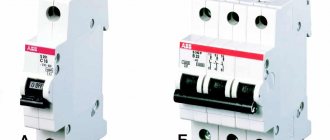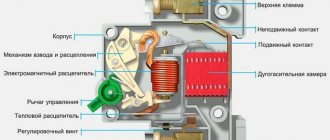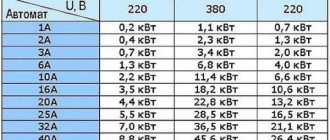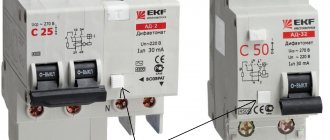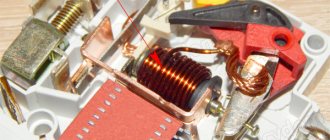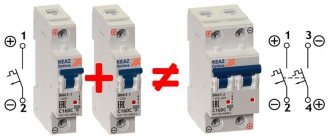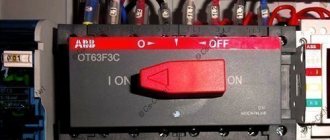What is the breaking capacity of a circuit breaker
A row of circuit breakers in a panel.
The circuit breaker is installed in the power supply circuit. If the power consumption increases excessively, the bimetallic element heats up. At a certain temperature level, a significant change in its shape breaks the contact of the conductor line.
Another protective device breaks the circuit when a strong current occurs. In addition to a short circuit, a similar reaction is caused by connecting an overly powerful reactive load, for example, a welding machine. In a dangerous situation, an electromagnetic coil moves the switch operating mechanism.
The breaking capacity of a circuit breaker is a complex parameter. It characterizes the guaranteed performance of basic functions by equipment in the event of emergency situations.
Selection and calculation of circuit breakers
Knowing the characteristics of the AB, you can determine which machine is suitable for a particular purpose. But before choosing the optimal model, it is necessary to make some calculations with which you can accurately determine the parameters of the desired device.
Step 1. Determining the power of the machine
When choosing a machine, it is important to take into account the total power of the connected devices.
For example, you need an automatic machine to connect kitchen appliances to power. Let's say a coffee maker (1000 W), a refrigerator (500 W), an oven (2000 W), a microwave oven (2000 W), and an electric kettle (1000 W) will be connected to the outlet. The total power will be equal to 1000+500+2000+2000+1000=6500 (W) or 6.5 kV.
The table shows the rated power of some household appliances required to operate them. According to the regulatory data, the cross-section of the power wire for their power supply and the circuit breaker for protecting the wiring are selected (+)
If you look at the table of circuit breakers by connection power, take into account that the standard wiring voltage in domestic conditions is 220 V, then a single-pole or double-pole 32A circuit breaker with a total power of 7 kW is suitable for operation.
It should be noted that more power consumption may be required, since during operation it may be necessary to connect other electrical appliances that were not initially taken into account. To provide for this situation, a multiplying factor is used in calculations of total consumption.
Let’s say that by adding additional electrical equipment, it was necessary to increase the power by 1.5 kW. Then you need to take the coefficient 1.5 and multiply it by the resulting calculated power.
In calculations it is sometimes advisable to use a reduction factor. It is used when the simultaneous use of several devices is impossible. Let's say the total wiring power for the kitchen was 3.1 kW. Then the reduction factor is 1, since the minimum number of devices connected at the same time is taken into account.
If one of the devices cannot be connected with others, then the reduction factor is taken less than one.
Step#2. Calculation of the rated power of the machine
Rated power is the power at which the wiring does not turn off. It is calculated using the formula:
where M is power (Watt), N is mains voltage (Volt), CT is the current strength capable of passing through the machine (Ampere), is the value of the cosine of the angle, which takes the value of the shift angle between phases and voltage. The cosine value is usually equal to 1, since there is practically no shift between the phases of current and voltage.
From the formula we express ST:
We have already determined the power, and the network voltage is usually 220 Volts.
If the total power is 3.1 kW, then
The resulting current will be 14 A.
For calculations with a three-phase load, the same formula is used, but angular shifts, which can reach large values, are taken into account. Usually they are indicated on the connected equipment.
Step#3. Rated current calculation
You can calculate the rated current using the wiring documentation, but if it is not available, then it is determined based on the characteristics of the conductor. The following data is required for calculations:
In domestic conditions, the wiring is usually located in the wall.
To calculate the cross-sectional area you will need a micrometer or caliper. It is necessary to measure only the conductive core, and not the wire and insulation
Having made the necessary measurements, we calculate the cross-sectional area:
In the formula, D is the diameter of the conductor (mm),
S is the cross-sectional area of the conductor (mm2).
Next we use the table below.
By determining what material the conductor cores were made of and calculating the cross-sectional area, you can determine the current and power indicators that the electrical wiring can withstand. Data given for wiring hidden in the wall (+)
Taking into account the data obtained, we select the operating current of the machine, as well as its nominal value. It must be equal to or less than the operating current. In some cases, it is permissible to use machines with a rating exceeding the effective wiring current.
Step#4. Determination of time-current characteristic
To correctly determine the VTX, it is necessary to take into account the starting currents of the connected loads. The necessary data can be found using the table below.
The table shows some types of electrical devices, as well as the inrush current multiplicity and pulse duration in seconds (+)
According to the table, you can determine the current strength (in Amperes) when the device is turned on, as well as the period after which the maximum current will occur again.
For example, if you take an electric meat grinder with a power of 1.5 kW, calculate the operating current for it from the tables (it will be 6.81 A) and, taking into account the multiplicity of the starting current (up to 7 times), we obtain a current value of 6.81 * 7 = 48(A). A current of this strength flows at intervals of 1-3 seconds.
Considering the VTK graphs for class B, you can see that if there is an overload, the circuit breaker will trip in the first seconds after starting the meat grinder. Obviously, the multiplicity of this device corresponds to class C, so an automatic machine with characteristic C must be used to ensure the operation of an electric meat grinder.
For domestic needs, switches that meet characteristics B and C are usually used. In industry, for equipment with large multiple currents (motors, power supplies, etc.), a current of up to 10 times is created, so it is advisable to use D-modifications of the device. However, the power of such devices, as well as the duration of the starting current, should be taken into account.
Autonomous automatic switches differ from conventional ones in that they are installed in separate distribution boards. The functions of the device include protecting the circuit from unexpected power surges and power outages in the entire or a specific section of the network.
remstrdom.ru
Which OS to choose for the machine
The value of this parameter is indicated by a special color marking and a number (kA) at the bottom of the front panel. In the last century, the relatively small consumption of electricity by domestic households implied the possibility of using protective devices of 3.5 kA or less. However, these days, experienced experts recommend choosing machines as follows:
- 4.5 kA – separate groups of consumers;
- 6 kA – input of residential power supply;
- 10 kA – outgoing distribution lines of an apartment building.
Corrections are made taking into account the characteristics of a particular project. The increased breaking capacity of the circuit breaker (AB) is useful at a short distance to the local substation and industrial enterprises.
Classification of circuit breakers
The machine almost instantly disconnects the line entrusted to it, which eliminates damage to the wiring and equipment powered from the network. After the shutdown has been completed, the branch can be restarted immediately without replacing the safety device.
Typically, circuit breakers are selected based on four key parameters - rated breaking capacity, number of poles, time-current characteristic, rated operating current.
According to rated breaking capacity
This characteristic indicates the permissible short circuit current (SC), at which the switch will trip and, opening the circuit, will de-energize the wiring and devices connected to it.
According to this parameter, there are three types of machines - 4.5 kA, 6 kA, 10 kA.
- 4.5 kA (4500 A) circuit breakers are usually used to prevent damage to power lines of private residential properties. The wiring resistance from the substation to the short circuit is approximately 0.05 Ohm, which gives a maximum current of about 500 A.
- 6 kA (6000 A) devices are used to protect against short circuits in the residential sector and public places, where line resistance can reach 0.04 Ohm, which increases the likelihood of a short circuit up to 5.5 kA.
- 10 kA (10,000 A) circuit breakers are used to protect industrial electrical installations. Currents of up to 10,000 A can occur in a short electrical circuit located close to a substation.
Before choosing the optimal modification of the circuit breaker, it is important to understand whether short-circuit currents exceeding 4.5 kA or 6 kA are possible?
The rated breaking capacity is indicated in the documentation for the switch and on the case in the form of a code - 4500A, 600A, 10000A or 4.5kA, 6kA, 10kA. On the front of the device there is information about the manufacturer, model, rated voltage, consisting of time-current characteristics, operating current
The machine is switched off when the specified values are short-circuited. Most often, switches of the 6000 A modification are used for domestic needs.
4500 A models are practically not used to protect modern electrical networks, and in some countries their use is prohibited.
If you are interested in how to correctly convert Amps to Watts, we recommend that you familiarize yourself with the material presented in the following article.
When a short circuit is registered automatically, the shutdown is performed by an electromagnetic coil (situation A). When the rated currents are exceeded, the network is opened by a bimetallic plate (situation B)
The job of a circuit breaker is to protect wiring (not equipment and users) from short circuits and from insulation melting when currents pass above rated values.
By number of poles
This characteristic indicates the maximum possible number of wires that can be connected to the AV to protect the network.
They are switched off when an emergency occurs (when the permissible current is exceeded or the level of the time-current curve is exceeded).
This characteristic indicates the maximum possible number of wires that can be connected to the AV to protect the network. They are switched off when an emergency occurs (when the permissible current is exceeded or the level of the time-current curve is exceeded).
Image gallery
Photo from
Specifics of single-pole circuit breakers
Place of installation of a two-pole circuit breaker
Using three-pole circuit breakers
Installation of a four-pole circuit breaker
Single pole circuit breakers
A single-pole type switch is the simplest modification of the machine. It is designed to protect individual circuits, as well as single-phase, two-phase, three-phase electrical wiring. It is possible to connect 2 wires to the switch design - the power wire and the outgoing wire.
The functions of a device of this class include only protecting the wire from fire. The neutral of the wiring itself is placed on the zero bus, thereby bypassing the machine, and the grounding wire is connected separately in the ground bus.
The connection of a single-pole AB is made with a single-core wire, but sometimes two-core cables are used. The power supply is connected at the top of the machine, and the protected line at the bottom, which simplifies installation. Installation takes place on an 18 mm din rail
A single-pole circuit breaker does not perform the function of an input circuit breaker, since when it is forced to turn off, the phase line is broken, and the neutral is connected to the voltage source, which does not provide a 100% guarantee of protection.
Double pole circuit breakers
When it is necessary to completely disconnect the electrical wiring network from voltage, a two-pole circuit breaker is used.
It is used as an introductory one, when during a short circuit or network failure, all electrical wiring is de-energized simultaneously. This makes it possible to carry out timely repairs and modernization of circuits absolutely safely.
Two-pole circuit breakers are used in cases where a separate switch is needed for a single-phase electrical appliance, for example, a water heater, boiler, machine tool.
The connection of a two-pole circuit breaker takes into account the electrical protection circuit using a 1- or 2-core wire (the number of wires depends on the wiring diagram). Installation is carried out on a 36 mm DIN rail
The machine is connected to the protected device using 4 wires, two of which are power wires (one of them is directly connected to the network, and the second supplies power with a jumper) and two are outgoing wires that require protection, and they can be 1-, 2- , 3-wire.
Three-pole circuit breakers
To protect a three-phase 3- or 4-wire network, three-pole circuit breakers are used. They are suitable for star connection (the middle wire is left unprotected, and the phase wires are connected to the poles) or triangle type (with the center wire missing).
If there is an accident on one of the lines, the other two are switched off independently.
The connection of a three-pole AB is made with 1-, 2-, 3-wire wires. Installation requires a 54mm wide DIN rail.
The three-pole switch serves as an input and common switch for all types of three-phase loads. The modification is often used in industry to provide current to electric motors.
Up to 6 wires are connected to the model, 3 of them are phase wires of a three-phase electrical network. The remaining 3 are protected. They represent three single-phase or one three-phase wiring.
Four-pole circuit breakers
To protect a three- or four-phase electrical network, for example, a powerful motor connected according to the “star” principle with a zero point removed, a four-pole circuit breaker is used. It is used as an input switch for a three-phase four-wire network.
The four-pole switch is connected using a 1-, 2-, 3-, 4-wire wire, the diagram depends on the type of connection, the housing is installed on a 73 mm wide DIN rail
It is possible to connect eight wires to the machine body, three of them are phase wires of the electrical network (+ one neutral) and four are outgoing wires (3 phase + 1 neutral).
Single-phase consumers are powered by a voltage of 220 V, which can be obtained by taking one of the phases and the neutral conductor (neutral) of the electrical network. That is, in this case, in addition to the three phases of the electrical network, there is one more conductor - neutral, therefore, to protect and switch such an electrical network, four-pole circuit breakers are installed, which break all four conductors.
According to the time-current characteristic
ABs may have the same rated load power, but the characteristics of electricity consumption by the devices may be different.
Power consumption may be uneven and vary depending on the type and load, as well as when a device is turned on, turned off, or continuously operated.
Fluctuations in power consumption can be quite significant, and the range of their changes can be wide. This leads to the machine turning off due to exceeding the rated current, which is considered a false network shutdown.
To eliminate the possibility of inappropriate operation of a fuse during non-emergency standard changes (increasing current, changing power), circuit breakers with certain time-current characteristics (TCC) are used.
This allows you to operate circuit breakers with the same current parameters with arbitrary permissible loads without false tripping.
VTX show after what time the switch will operate and what indicators of the ratio of current strength and direct current of the machine will be in this case.
Features of machines with characteristic B
A machine with the specified characteristic turns off within 5-20 seconds. The current indicator is 3-5 rated currents of the machine. These modifications are used to protect circuits that power standard household appliances.
Most often, the model is used to protect the wiring of apartments and private houses.
Feature C - operating principles
The machine with the nomenclature designation C switches off in 1-10 seconds at 5-10 rated currents.
Switches of this group are used in all areas - in everyday life, construction, industry, but they are most in demand in the area of electrical protection of apartments, houses, and residential premises.
Operation of switches with characteristic D
D-class machines are used in industry and are represented by three-pole and four-pole modifications. They are used to protect powerful electric motors and various 3-phase devices.
The response time of the AV is 1-10 seconds at a current multiple of 10-14, which allows it to be effectively used to protect various wiring.
The lower part of the graph shows the multiple of the rated current values, and the vertical line shows the shutdown time. For characteristic B, shutdown occurs when the effective current exceeds the rated current by 3-5 times, for C - 5-10 times, for D - 10-14 times
Powerful industrial motors operate exclusively with motors with characteristic D.
Maybe
Rated breaking capacity AB
In reality, one has to take into account the characteristics of a particular accident. The cos ϕ value has a significant influence on the development of unfavorable processes. This parameter determines the energy potential of the combination of basic electrical parameters.
They normalize the current value at which the machine will break the circuit and retain sufficient functionality to perform similar actions in normal mode. It should be emphasized that thematic standards assume a periodic component of the short-circuit current. The following designations of circuit breaker breaking capacity ratings are used for different groups of devices based on their intended purpose:
- industrial machines – Icu (limit);
- household models – Icn (operational).
The rated breaking capacity of a circuit breaker is a basic parameter that determines the reliability of the protective device. Technological checks during production and certification tests are carried out taking into account the rate of power supply circuit breakage in the relevant categories:
- A – instantly;
- B – with a set delay.
Tests are performed according to the standard program:
- simulate a short circuit followed by turning off the machine;
- check functionality;
- repeat the procedure for different values of cos ϕ.
At the final stage, the compliance of the basic technical parameters with the manufacturer’s passport data is clarified.
In addition to the safety of insulation, the reliability and speed of separation of contact groups and the absence of mechanical damage are monitored.
Selecting a circuit breaker
A circuit breaker that protects a person from electric shock is called a circuit breaker. If the normal flow of current from the protective circuit breaker to the consumer is disrupted. This happens when a large number of different electrical appliances are turned on or when some of them are faulty.
In such situations, the circuit breakers are triggered and the network is de-energized. Too much current leads to damage to any household electrical appliances. It also causes overheating of electrical wiring, sometimes ignition and fire. Hence the main purpose of the machine is to open the circuit before the high current damages the devices and causes heating of the wiring. This will protect the wiring and devices.
AUTOMATIC PROTECTION types
There are 2 types: RCD, Residual current device and Differential circuit breaker
RCD
Their differences are that the RCD does not provide short circuit (short circuit) protection.
For the RCD to work correctly, it must be protected from too much electric current. To do this, circuit breakers are connected in front of the device itself.
The RCD turns off circuits when current leakage occurs, possibly when a person touches the wire or in the event of insulation damage. In devices, the leakage current value can be 10 mA, 30 mA and 300 mA. Residential premises are equipped with protection devices with a shutdown current of 30 mA.
For an RCD, the main function is to protect people from electric current of 10 mA 30 mA and from fires at current values of 10 mA, 30 mA, 300 mA.
Differential automatic (YES)
Differential automatic device (DA) - a device for combining RCD and automatic shutdown.
YES works for quick shutdown. Their effective purpose is to prevent electric shock to people. YES they instantly turn off the network when a person touches a surface with a passing current. Another option is when the insulation of non-current carrying elements is broken. Thus, the YES breaks the network - when there is a current leak to the ground, as well as during a short circuit and when the circuit is overloaded.
The price is YES more than that of an RCD with an automatic machine. According to the characteristics, YES and RCDs have the same cut-off currents as Residual Current Devices, and the same values as automatic machines. In practice, a single-phase (single-pole) circuit breaker is used to disconnect phase wiring.
They also use a two-phase, or machine with two poles, and a “phase + neutral” type machine, in which the phase (L) and neutral (N) wires are immediately opened together.
Three-phase (three-pole) and four-phase (four-pole) circuit breakers are used for voltages of 380 volts.
Please pay attention to the following machine data
Rated current shows the value of the operating current (in amperes). When this value is exceeded, the machine disconnects the contacts. The machines are produced with standard ratings: 6, 10, 13, 16, 20, 25, 32, 40, 50, 63, 80, 100 A.
Trip class means the short-term permissible current value at which the machine will NOT operate. There are the following classes B C and D.
- “B” is used in networks with voltages from 3 to 5 rated current values.
- Class “C” is used in residential and work areas where current may be 5–10 times higher than the rated value.
- Class “D” is in demand in networks where currents may occur that are 10–50 times higher than the rated value.
Breaking capacity (kA) is the maximum amount of current that the machine can tolerate in the event of a short circuit in the line, while maintaining its functionality.
Cut-off current for RCD and IM. These indicators are always written on the device; the price of such a device increases with increasing parameters. When creating a home network, it is recommended to use a common circuit breaker (RCD, IM) at the input of the circuit and install a separate circuit breaker (class C) for each consumer circuit.
When choosing the rated current of a linear machine, you need to take into account:
- diameter and material of the cable used:
- Add up the power of all electrical appliances used.
| Important! For a copper wire with a diameter of 2.5 mm, a current of up to 25 A is allowed, and if the power of the devices used at a voltage of 220 volts is less than 5.5 kW, a C25 automatic machine is required. |
For the machine, you need to install an RCD (AM) with a cut-off current at the input:
- 30 mA – for dry rooms;
- 10 mA – for wet rooms.
The rated current value should be one step higher than the linear current (according to the principle of stepped network protection).
Maximum switching capacity of the circuit breaker
The current standards establish the procedure for conducting special tests. In particular, they check the continued performance after multiple short circuits. It should be understood that when the current and voltage vectors coincide, the circuit is broken at a lower energy potential. In the opposite situation (cos ϕ = 0), the risk of equipment damage increases. If cos ϕ = 0.5, it is recommended to select the maximum switching capacity of the circuit breaker with Icu in the range of 6-10 kA.
RCD example
RCD IEK BA47-29
- Rated current - 32 A;
- Leakage current - 30 mA;
- Residual current characteristic - responds only to alternating leakage current;
- Designed for alternating voltage - up to 230V 50Hz;
- Rated short-circuit current - 3000A.
- Number of poles - 2.
We select this RCD for a circuit breaker rated up to 25A.
There are protection devices that combine RCD and VA, they are called differential circuit breakers. We recommend installing it to save space in the panel.
Working largest OS
The likelihood of the worst case situation is extremely low. Typically, when emergency situations occur, short-circuit currents are significantly less than the maximum breaking capacity of the circuit breaker (Icu). This explains the long service life of the protective devices under real operating conditions.
However, we cannot exclude the possibility of a short circuit occurring again within a short period of time after turning on the power. To increase the reliability margin, an additional parameter Ics is normalized in industrial models. The corresponding value is indicated in the accompanying documentation for the product as a % of Icu according to the standard gradation:
- 25;
- 50;
- 75;
- 100.
Standard tests check the preservation of the switching capabilities of the circuit breaker after 3 cycles with a circuit break after a short circuit. After completing the procedure, the compliance of the shutdown speed and other technical parameters with the manufacturer’s passport data is clarified.
You will have to pay more for a high-quality machine from a well-known brand. However, such products are created according to the rule of equality of Icu and Ics (100%).
Additional tests establish the actual value of the maximum current (peak level) - Icm. In this case, in addition to the signal amplitude, the rate of change of energy parameters is important. In the calculation formulas, an appropriate correction factor is used, which in turn depends on cos ϕ.
Switch selection
The switching capacity of a switch is understood as its ability to switch off and on electrical circuits during a short circuit. Accordingly, the concepts of rated switching current Iot.nom and rated switching current Ivk.nom are established.
Rated breaking current
The severity of the shutdown process (in the part related to the current) is determined mainly by the effective value of the periodic component of the switched off current. Therefore, it was agreed that by the rated shutdown current we understand the maximum permissible effective value of a purely symmetrical current or the maximum permissible value of the periodic component of the asymmetric current at the moment τ of opening the arc extinguishing contacts. The switch must reliably turn off these currents with: asymmetry β=iaτ/(√2 Iпτ) - up to the rated value βnom=iaτnom/(√2 Iot.nom); mains voltage - up to the highest operating voltage Urab.nb; nominal parameters of recovery voltage; normalized cycles of on and off operations.
The effective value of the periodic component of the short-circuit current at a certain moment τ is determined from the envelope curves, as shown in Fig. 1.
Fig.1. Oscillogram of switched-off short-circuit current: AA' and BB' - envelope curves; EE' - moment of opening of arc extinguishing contacts
The estimated time τ of opening the arc extinguishing contacts (in seconds) is determined as the sum of the switch’s own shutdown time tot.sb and the minimum response time of the relay protection, taken equal to 0.01 s:
τ=tfrom.sb+0.01 (1)
The actual switch-off time is indicated by the manufacturers. It is calculated from the moment the shutdown command is given until the moment the arc extinguishing contacts open.
Usually the nominal asymmetry is expressed as a percentage:
βnom=iaτnom100/(√2 Iot.nom)
Fig.2. Nominal asymmetry of the switched current as a function of the calculated time τ
According to GOST 687-78, the nominal asymmetry is set as a function of time τ (Fig. 2). The curve βnom(τ) is an exponential with the index τ/Ta. The value is taken to be 0.045s, which corresponds to the average value at most points in the system. For a short circuit near powerful power plants, Ta>0.045s, which should be taken into account when choosing a circuit breaker. At τ>70ms the value of βnom should be considered equal to zero.
When choosing a circuit breaker based on the rated breaking current, the following conditions must be met:
(2)
where iaτnom=√2 Iot.nomβnom/100 is the rated value of the aperiodic component of the shutdown current.
The left side of these inequalities shows the rated parameters of the switch, and the right side shows the corresponding design values.
If the second requirement is not met, i.e. the calculated value of the aperiodic component of the current exceeds the rated value, then in this case the conditional values of the total shutdown currents should be compared, namely:
√2 Irel.nom(1+βnom/100)≥√2 Iпτ(1+β/100), (3)
where
From the last expression it follows that the switch is capable of disconnecting the short-circuit current at a value of iaτ exceeding the rated value, provided that the rated disconnecting current exceeds the rated current Iпτ in relation
Rated switching current
The rated switching current is understood as the highest short-circuit current that the switch can reliably switch on. Manufacturers determine this current by the highest effective value, which is set equal to the rated breaking current
Ivk.nom=Iot.nom,
and the largest instantaneous value, which is set equal to
ivk.nom=2.55 Iot.nom. (4)
It follows that a circuit breaker selected for its rated breaking current is also capable of switching on a circuit with a rated turning current. Therefore, no additional verification is required.
Features of AVs that define the OS
A study of current market offers confirms a noticeable increase in cost as the circuit breaker's breaking capacity increases. Which model to choose will become clear after a comprehensive assessment of the project.
A device designed for a lower rating will not perform its functions. In the worst situation, even if the housing is destroyed, electrical contact will remain. The development of an emergency situation provokes additional breakdowns and costs.
How to choose a machine: 4.5kA, 6kA or 10kA?
When choosing a modular “automatic machine” you will definitely come across the parameter “ breaking capacity
"
It is denoted in kiloamperes
(
kA
). This means the amount of current that the machine will withstand in the event of a short circuit, while maintaining its functionality. That is, it will switch off and not burn out.
You may find the same brand with different breaking capacities. 4.5 kA are on sale.
,
6kA
and
10kA
(anything larger is already an industrial circuit breaker).
The higher this indicator, the higher the price.
Machines PL4, PL6 and PL7
For example, let’s look at the slot machines of three series: PL4
with a breaking capacity of
4.5 kA, PL6
and
PL7
(at
6 kA
and
10 kA
, respectively).
Approximate cost of each:
PL4-C16/1 – 216r.
PL6-C16/1 – 269r.
PL7-C16/1 – 466 rub.
The difference between the cost of the first two is already noticeable, about 20%, and a 10 kA model will cost 2 times more than a 4.5 kA model.
What causes the difference? And when looking for modular protection devices, is it necessary to pay more in pursuit of the highest breaking capacity?
In what cases should you choose 4.5kA, 6kA and 10kA circuit breakers?
The majority use a gradation of values of 4.5 kA, 6 kA and, less often, 10 kA. These numbers are indicated by the manufacturer in a rectangle on the front panel of the case.
What do they mean:
for example, a
4.5 kA
.
If a short circuit of up to 4.5 kA occurs in this section of the circuit, it will operate effectively, break the emergency electrical circuit and, at the same time, will not fail.
In the event that the short-circuit current exceeds the limit value guaranteed by the manufacturer, it is likely that the machine will melt or burn out without having time to complete its task.
Therefore, when choosing a rating, determine the probability of occurrence of emergency values exceeding 4.5 kA or 6 kA.
According to the PUE
(Chapter 3.1; 1.7; 7.1; Section 6), in networks up to 1000V, for reliable shutdown, the circuit breaker must correspond to the maximum short-circuit current. If you do not delve into the calculations of the short circuit, you can take as an example the general conditions for installation in apartment buildings:
at 4.5 kA - outgoing in apartment panels;
at 6kA - incoming ones in apartment panels;
at 10 kA - outgoing in the input distribution devices (at the input of the supply line into the house).
Short circuit
The fact is that the magnitude of the current (including short circuit) in the conductor is inversely proportional to the magnitude of the resistance (does everyone remember Ohm’s Law from the school physics course?) - i.e., the higher the resistance, the lower it is.
In turn, the resistance of the wiring is directly dependent on a number of factors, including the proximity of the substation (the closer, the higher the values of short circuit currents that can occur), the wiring material, and the quality of the connections.
To prevent emergency situations in old residential buildings,
in rural areas and country houses, where battered wiring is made of aluminum cable, you can most often find the 4.5 kA marking. This is enough.
In new multi-apartment buildings,
Where good wiring is done using copper wires (copper cable has lower resistance than aluminum), the absolute values of short circuit currents are potentially increased. Here it is advisable to provide an electrical strength of up to 6 kA. By the way, the demand for 6kA automatic machines is predictably growing.
What about the most expensive ones for 10kA? Considered to be exceptionally suitable for the protection of industrial installations. However, currents of such magnitudes may well form in the immediate vicinity of an electrical substation.
Therefore, to protect power lines of cottages, townhouses and other buildings on 2-3 floors, especially those located near the transformer substation
, the choice of 10kA input machines is a reasonable decision.
Under whose brand should you buy the machines?
It is interesting that, depending on the breaking capacity parameter, the range of low-voltage equipment from well-known brands is quite different.
Let's say you decide to limit yourself to 4.5 kA. Be prepared for the fact that during the day you will not find such models from several leading manufacturers of low-voltage equipment - for example, ABB, General Electric, Hager.
The fact is that in European countries modules with a breaking capacity below 6 kA are not used
, as not meeting their higher safety standards.
Other brands produce 4.5 kA series specifically for the CIS market. For example, the much-advertised “Brownie” line from Schneider Electric. It's not a problem to find one at IEK either.
Bottom line
When choosing, you cannot be guided solely by considerations of economy and outdated recommendations.
In new apartments and private houses
with powerful energy consumers and high-quality copper wiring (cable cross-section from 4 mm2 for a one-room apartment and from 6 mm2 for a more spacious home), it is appropriate to use circuit breakers
with a breaking capacity of 6 kA.
For filling a modular panel in a cottage
,
townhouse
or other building with 2-3 floors, provide a safety margin at the “input”.
Especially at a facility located near a transformer substation. If the budget allows, take a higher level of protection, then 10 kA.
#electrical #helpful tips #repair #electricity #circuit breakers
Thank you for your attention and don't miss the next articles.
Subscribe.
Contact the specialists at xiot.ru and we will develop for you a detailed project of any complexity.
You can purchase automation equipment in our store xiot-shop.ru
You can find more useful tips, reviews, interesting articles, smart home equipment and news about it on the news page of our website , YouTube and Instagram .
Design features
In practice, the definition of “ultimate switching resistance” is used. This indicator is used to determine the resistance of the machine to maximum loads. If a one-time PKS is indicated, then the protection will work only once. They increase the service life of equipment by upgrading functional blocks. In particular, they improve heat dissipation to maintain the integrity of the structure in short-circuit mode and reduce the negative impact on contact groups.
It is recommended to pay attention to design features that simplify installation and inspection. Some models have special holes for quick visual inspection. Be sure to consider the proximity of transformers and other potential sources of dangerous voltage surges. The maximum breaking capacity of the circuit breaker is selected with a reserve.
Connected loads are checked in maximum consumption modes.

